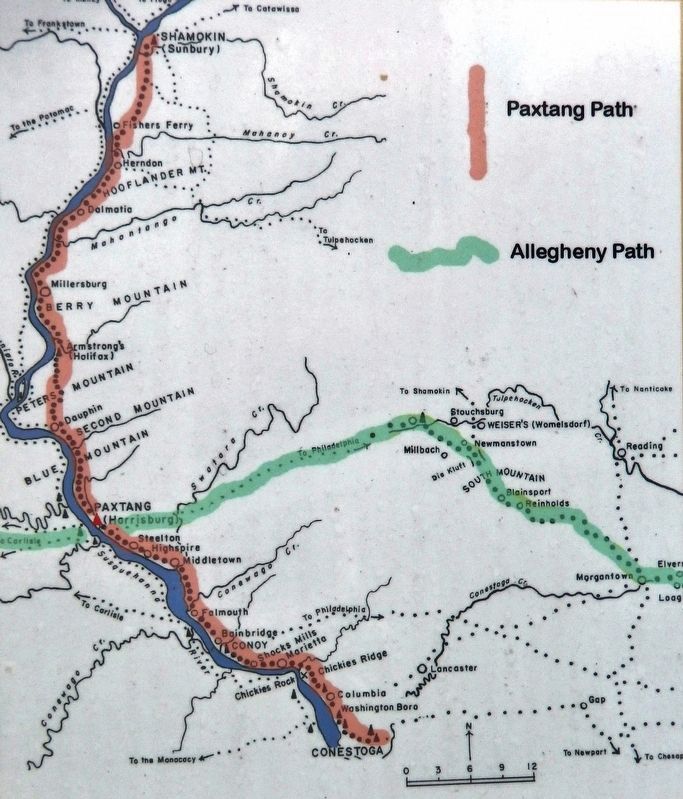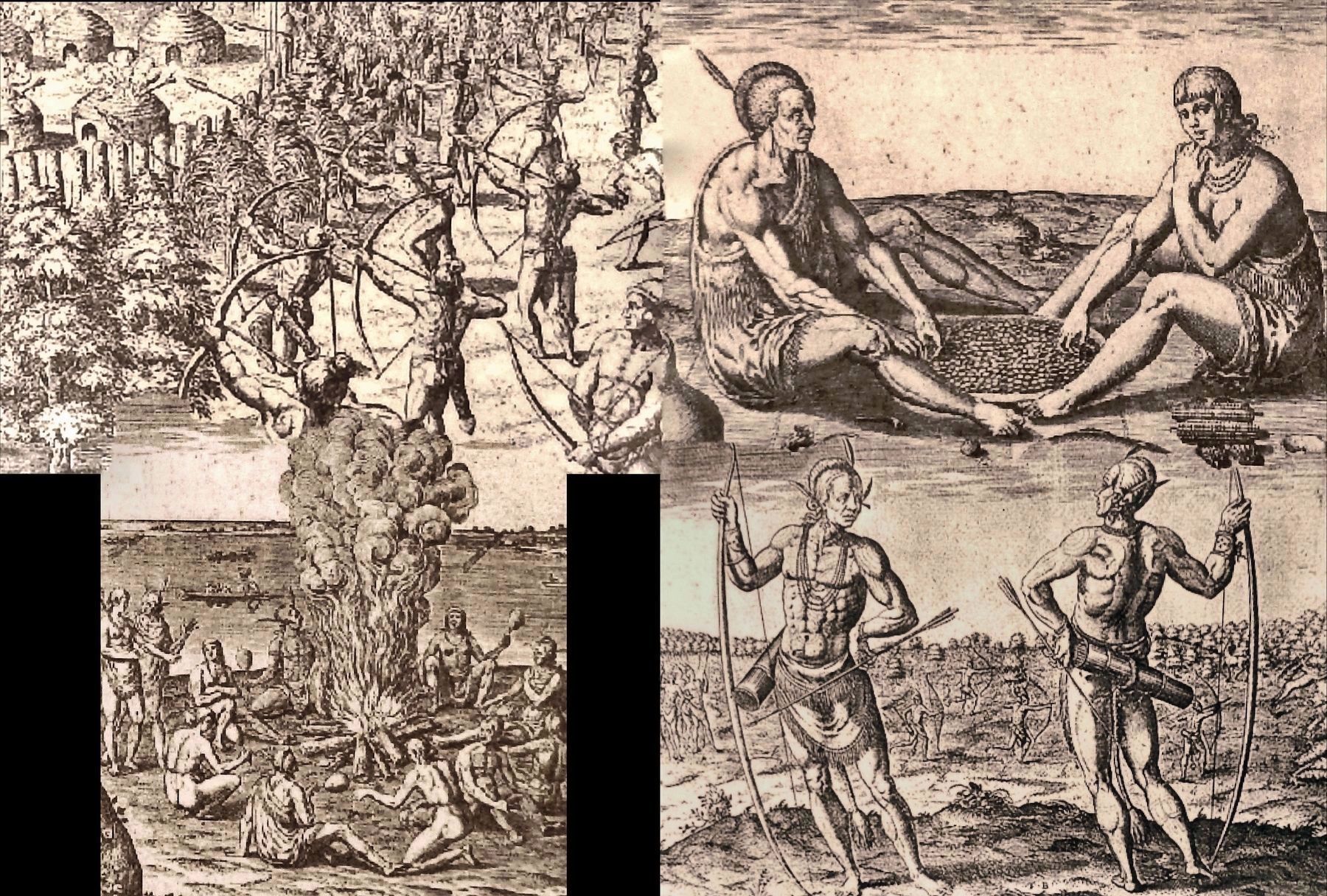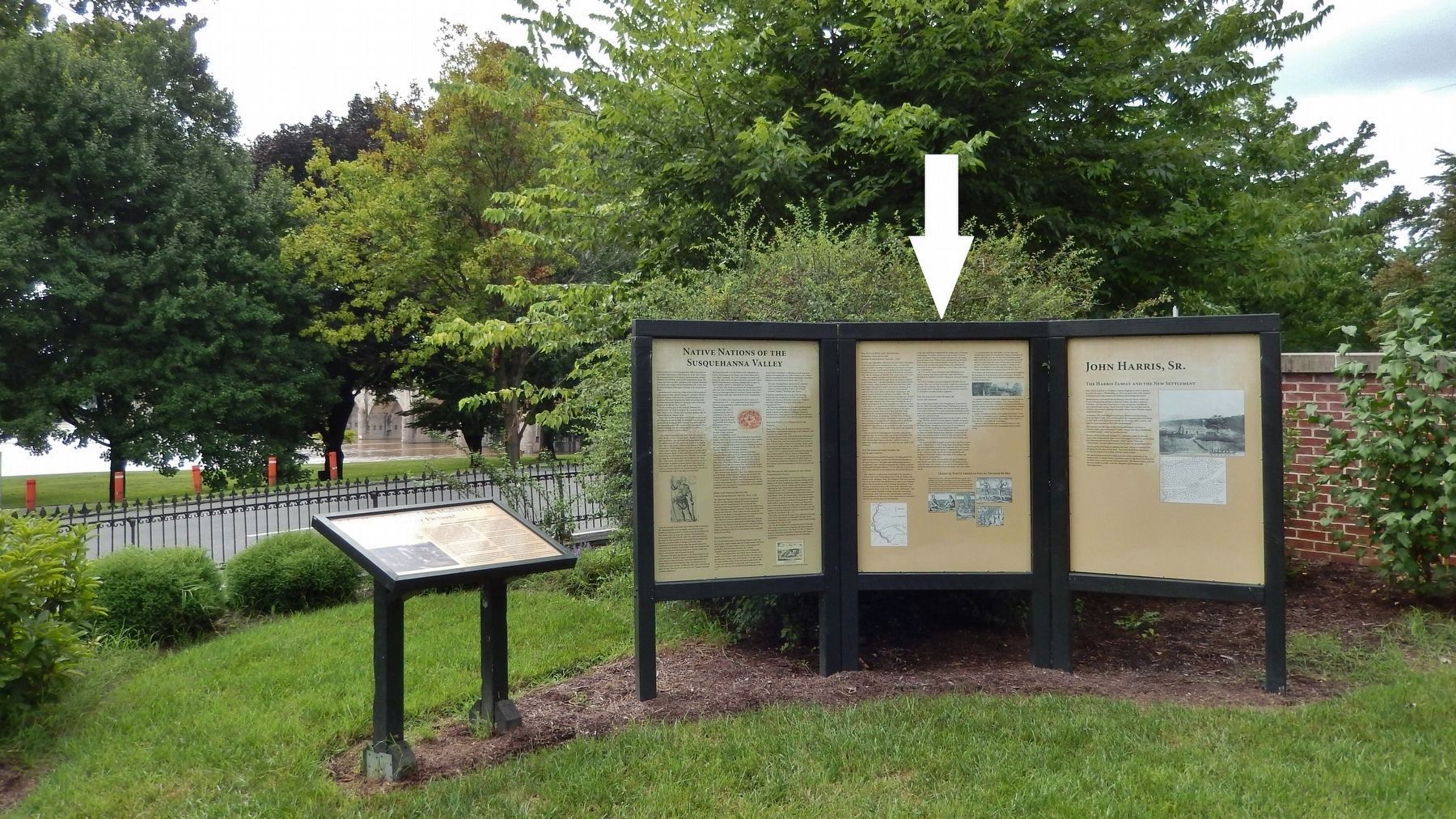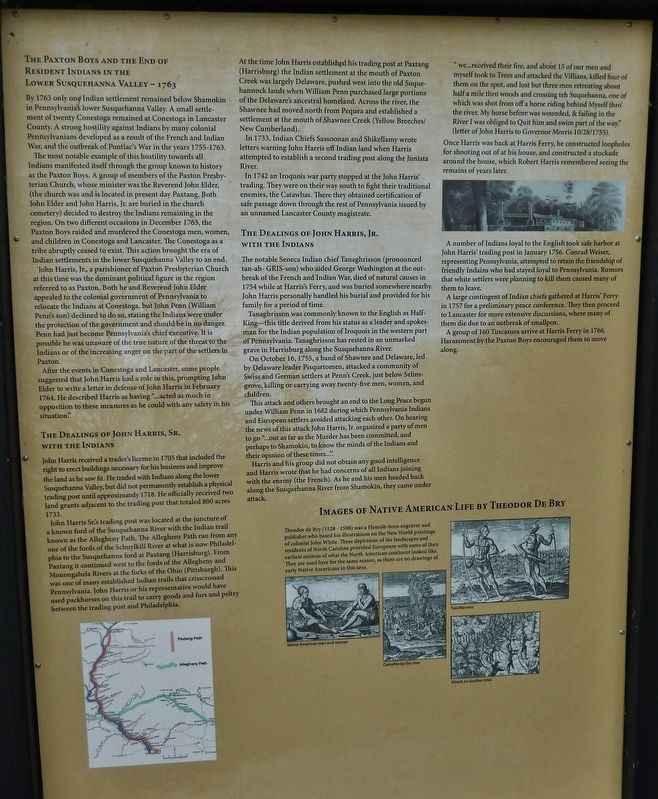Harrisburg in Dauphin County, Pennsylvania — The American Northeast (Mid-Atlantic)
Native Nations of the Susquehanna Valley
(panel 2)
Inscription.
The Paxton Boys and the End of the Resident Indians in the Lower Susquehanna Valley – 1763
By 1763 only one Indian settlement remained below Shamokin in Pennsylvania’s lower Susquehanna Valley. A small settlement of twenty Conestoga remained at Conestoga in Lancaster County. A strong hostility against Indians by many colonial Pennsylvanians developed as a result of the French and Indian War, and the outbreak of Pontiac's War in the years 1755-1763.
The most notable example of this hostility towards all Indians manifested itself through the group known to history as the Paxton Boys. A group of members of the Paxton Presbyterian Church, whose minister was the Reverend John Elder, (the church was and is located in present day Paxtang. Both John Elder and John Harris, Jr. are buried in the church cemetery) decided to destroy the Indians remaining in the region. On two different occasions in December 1763, the Paxton Boys raided and murdered the Conestoga men, women, and children in Conestoga and Lancaster. The Conestoga as a tribe abruptly ceased to exist. This action brought the era of Indian settlements in the lower Susquehanna Valley to an end.
John Harris, Jr., a parishioner of Paxton Presbyterian Church at this time was the dominant political figure in the region referred to as Paxton. Both he and Reverend John Elder appealed to the colonial government of Pennsylvania to relocate the Indians at Conestoga, but John Penn (William Penn's son) declined to do so, stating the Indians were under the protection of the government and should be in no danger. Penn had just become Pennsylvania's chief executive. It is possible he was unaware of the true nature of the threat to the Indians or of the increasing anger on the part of the settlers in Paxton.
After the events in Conestoga and Lancaster, some people suggested that John Harris had a role in this, prompting John Elder to write a letter in defense of John Harris in February 1764. He described Harris as having "…acted as much in opposition to these measures as he could with any safety in his situation.”
The Dealings of John Harris, Sr. with the Indians John Harris received a trader's license in 1705 that included the right to erect buildings necessary for his business and improve the land as he saw fit. He traded with Indians along the lower Susquehanna Valley, but did not permanently establish a physical trading post until approximately 1718. He officially received two land grants adjacent to the trading post that totaled 800 acres 1733.
John Harris Sr.’s trading post was located at the juncture of a known ford of the Susquehanna River with the Indian trail known as the Allegheny

2. Marker detail: The Allegheny Path
John Harris Sr.’s trading post was located at the juncture of a known ford of the Susquehanna River with the Indian trail known as the Allegheny Path. The Allegheny Path ran from any one of the fords of the Schuylkill River at what is now Philadelphia to the Susquehanna ford at Paxtang (Harrisburg).
At the time John Harris established his trading post at Paxtang (Harrisburg) the Indian settlement at the mouth of Paxton Creek was largely Delaware, pushed west into the old Suquehannock lands when William Penn purchased large portions of the Delaware's ancestral homeland. Across the river, the Shawnee had moved north from Pequea and established a settlement at the mouth of Shawnee Creek (Yellow Breeches/New Cumberland).
In 1733, Indian Chiefs Sassoonan and Shikellamy wrote letters warning John Harris off Indian land when Harris attempted to establish a second trading post along the Juniata River.
In 1742 an Iroquois war party stopped at the John Harris' trading. They were on their way south to fight their traditional enemies, the Catawbas. There they obtained certification of safe passage down through the rest of Pennsylvania issued by an unnamed Lancaster

3. Marker detail: Images of Native American Life by Theodor De Bry
Theodor de Bry (1528-1598) was a Flemish-born engraver and publisher who based his illustrations on the New World paintings of colonist John White. These depictions of the landscapes and residents of North Carolina provided Europeans with some of their earliest notions of what the North American continent looked like. They are used here for the same reason, as there are no drawings of early Native Americans in this area.
The Dealings of John Harris, Jr. with the Indians
The notable Seneca Indian chief Tanaghrisson (pronounced tan-ah- GRIS-son) who aided George Washington at the out-break of the French and Indian War, died of natural causes in 1754 while at Harris's Ferry, and was buried somewhere nearby. John Harris personally handled his burial and provided for his family for a period of time.
Tanaghrisson was commonly known to the English as Half-King - this title derived from his status as a leader and spokesman for the Indian population of Iroquois in the western part of Pennsylvania. Tanaghrisson has rested in an unmarked grave in Harrisburg along the Susquehanna River.
On October 16, 1755, a band of Shawnee and Delaware, led by Delaware leader Pisquetomen, attacked a community of Swiss and German settlers at Penn's Creek, just below Selinsgrove, killing or carrying away twenty-five men, women, and children.
This attack and others brought an end to the Long Peace begun under William Penn in 1682 during which Pennsylvania Indians and European settlers avoided attacking each other. On hearing the news of this attack John Harris, Jr. organized a party of men to go "…out as far as the Murder has been committed, and perhaps to Shamokin, to know the minds of the Indians and their opinion of these times…”
Harris

Photographed By Cosmos Mariner, August 20, 2018
4. Native Nations of the Susquehanna Valley Marker (wide view)
This is the right panel of a two-panel marker set, located in the middle of this three-panel kiosk. There is a related, but different, marker panel on the far right side of the three adjacent panels in this kiosk.
"we… received their fire, and about 15 of our men and myself took to Trees and attacked the Villians, killed four of them on the spot, and lost but three men retreating about half a mile thro woods and crossing the Suquehanna, one of which was shot from off a horse riding behind Myself thro' the river. My horse before was wounded, & failing in the River I was obliged to Quit him and swim part of the way."
(letter of John Harris to Governor Morris 10/28/1755).
Once Harris was back at Harris Ferry, he constructed loopholes for shooting out of at his house, and constructed a stockade around the house, which Robert Harris remembered seeing the remains of years later.
A number of Indians loyal to the English took safe harbor at John Harris' trading post in January 1756. Conrad Weiser, representing Pennsylvania, attempted to retain the friendship of friendly Indians who had stayed loyal to Pennsylvania. Rumors that white settlers were planning to kill them caused many of them to leave.
A large contingent of Indian chiefs gathered at Harris' Ferry in 1757 for a preliminary peace conference. They then proceed to Lancaster for more extensive discussions, where many of them died due to an outbreak of smallpox.
A group of 160 Tuscarora arrived at Harris Ferry in 1766. Harassment by the Paxton Boys encouraged them to move along.
Topics. This historical marker is listed in these topic lists: Colonial Era • Native Americans • Settlements & Settlers • Waterways & Vessels.
Location. 40° 15.397′ N, 76° 52.734′ W. Marker is in Harrisburg, Pennsylvania, in Dauphin County. Marker can be reached from the intersection of South Front Street and Mary Street, on the left when traveling south. Marker is located on the grounds of the John Harris Mansion, on the north side of the mansion. Touch for map. Marker is at or near this postal address: 219 South Front Street, Harrisburg PA 17104, United States of America. Touch for directions.
Other nearby markers. At least 8 other markers are within walking distance of this marker. John Harris, Sr. (here, next to this marker); a different marker also named Native Nations of the Susquehanna Valley (here, next to this marker); John Harris, Sr., and the Mulberry Tree (here, next to this marker); The Court House Bell (a few steps from this marker); John Harris Mansion (a few steps from this marker); Harrisburg's Grand Review of Black Troops (a few steps from this marker); a different marker also named John Harris Mansion (within shouting distance of this marker); In Memory of John Harris (within shouting distance of this marker). Touch for a list and map of all markers in Harrisburg.
More about this marker. This is the right panel of a two-panel marker set, located in the middle of a three-panel kiosk. There is a related, but different, marker panel on the far right side of the three adjacent panels in this kiosk.
Related markers. Click here for a list of markers that are related to this marker. Native Nations of the Susquehanna Valley
Credits. This page was last revised on August 25, 2018. It was originally submitted on August 18, 2018, by Cosmos Mariner of Cape Canaveral, Florida. This page has been viewed 442 times since then and 28 times this year. Photos: 1, 2, 3, 4. submitted on August 21, 2018, by Cosmos Mariner of Cape Canaveral, Florida. • Andrew Ruppenstein was the editor who published this page.
